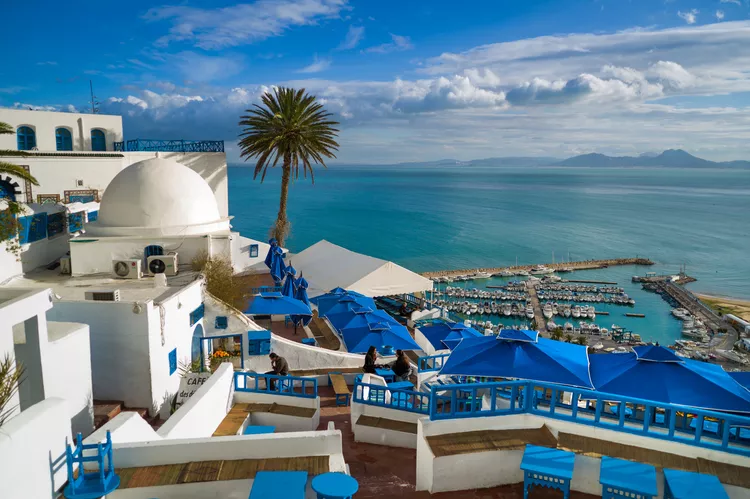Summary of Tunisia Travel Guide
One of the most popular tourist destinations in North Africa, Tunisia offers an incredibly diverse range of experiences. Along the Mediterranean coast, resort towns like Hammamet provide an abundance of sun and sea; while the southern Sahara is populated by dramatic desert landscapes, fascinating Berber villages, and abandoned Star Wars sets. Tunisia’s rich history during Roman times is evident in the well-preserved ruins at El Jem and Carthage. Moreover, Tunis offers an array of cultural and culinary experiences typical of a major capital.
Location
Tunisia is situated in North Africa along the Mediterranean coast, bordered by Algeria to the west and Libya to the southeast.
Geography
With a land mass of 59,984 square miles (155,360 square kilometers), Tunisia is slightly larger than the state of Georgia. The northern region is mountainous, gradually descending into the expansive Sahara Desert in the south.
Capital City
The capital of Tunisia is Tunis, located in the northern part of the country.
Population
According to a CIA World Factbook estimate, Tunisia’s population was approximately 11.4 million people in July 2017.
Language
The official language is Arabic, while French is widely used in commerce and spoken by nearly two-thirds of the population. Additionally, Berber serves as the principal language in the southern regions.
Religion
Tunisia’s official religion is Islam, with around 99% of the populace identifying as Sunni Muslims. The remaining 1% consists of Christians, Jews, and Shia Muslims.
Currency
The currency of Tunisia is the Tunisian dinar. For accurate exchange rates, you may use this online converter.
Climate
Northern Tunisia enjoys a Mediterranean climate characterized by hot, dry summers and mild, rainy winters. As you travel southward, the climate becomes increasingly arid, with the southern desert experiencing hot, dry weather year-round. Rainfall is scarce, although winter nights in the desert can be surprisingly cool.
When to Go
Tunisia is a year-round destination; however, the optimal time to explore the northern region is from May to October. Conversely, if you plan to visit the Sahara, consider traveling during the winter months (November to February) to avoid the scorching summer heat.
Key Attractions
Tunis
With its laid-back atmosphere and rich heritage, Tunis serves as a perfect starting point for your Tunisian adventure. Spend time exploring the winding streets and souks of the medina, or admire the Roman ruins at nearby Carthage. The French Ville Nouvelle quarter features many excellent dining options, while the Bardo Museum showcases some of the most renowned ancient mosaics in the country.
Sidi Bou Said
The picturesque town of Sidi Bou Said enchants visitors with its white domed houses and blue-painted doors reminiscent of Grecian architecture. Tourists flock here to enjoy breathtaking Mediterranean views and explore numerous art galleries, boutiques, and charming open-air cafés. To learn about the town’s unique architectural history, visit the Neo-Moorish residence of Baron Rodolphe d’Erlanger.
Grand Erg Oriental
Covering an area of 40,000 square kilometers, Tunisia’s section of the Grand Erg Oriental is a stunning desert landscape featuring sweeping dunes and hidden oases. You can explore this vast wonder by 4×4 vehicle or, as has been done for centuries, on the back of a camel. Keep an eye out for unique desert wildlife and enjoy the mesmerizing sunrises and sunsets.
El Jem
Located approximately 2.5 hours south of Tunis, El Jem was a Punic city that grew into a significant center of commerce during Roman times. Today, it boasts some of the best-preserved Roman ruins globally, including the UNESCO-recognized Amphitheatre of El Jem, a magnificent structure built in the 3rd century that once accommodated 35,000 spectators.
Getting There
The Tunis-Carthage International Airport (TUN) is the main entry point for most international travelers. It offers flights from various airlines, including Tunisair, Air France, Lufthansa, EgyptAir, and Royal Air Maroc. Currently, there are no direct flights from the United States to Tunis. Travelers from Australia, Canada, the United Kingdom, New Zealand, and the United States can enter Tunisia without a visa for stays of up to 90 days.
Medical Requirements
Ensure that your vaccinations are current, as the CDC recommends that travelers to Tunisia receive vaccinations for hepatitis A and typhoid. Depending on planned activities, consider rabies and hepatitis B vaccinations as well. Notably, there is no risk of malaria in Tunisia.





